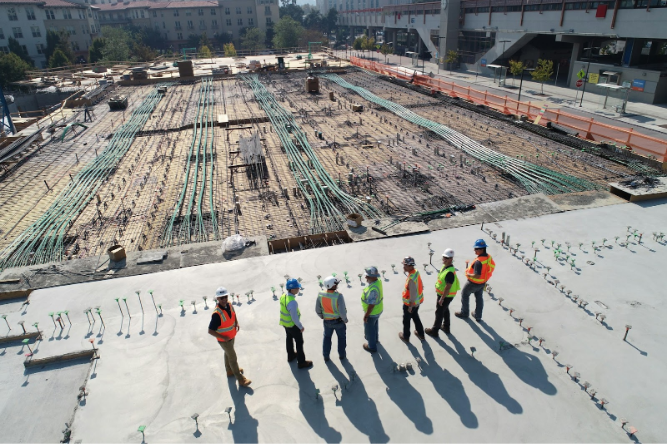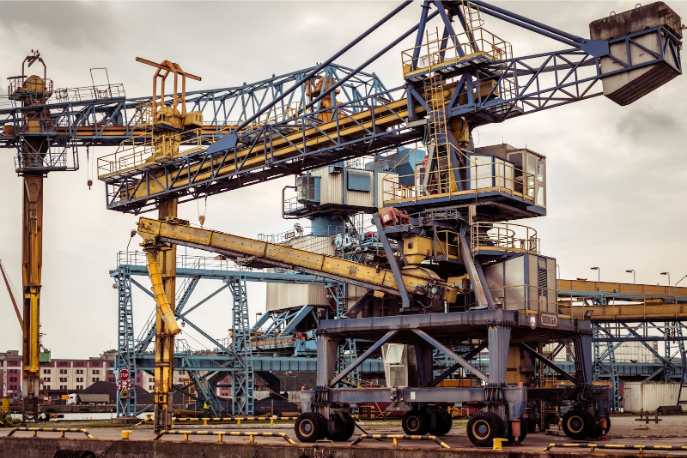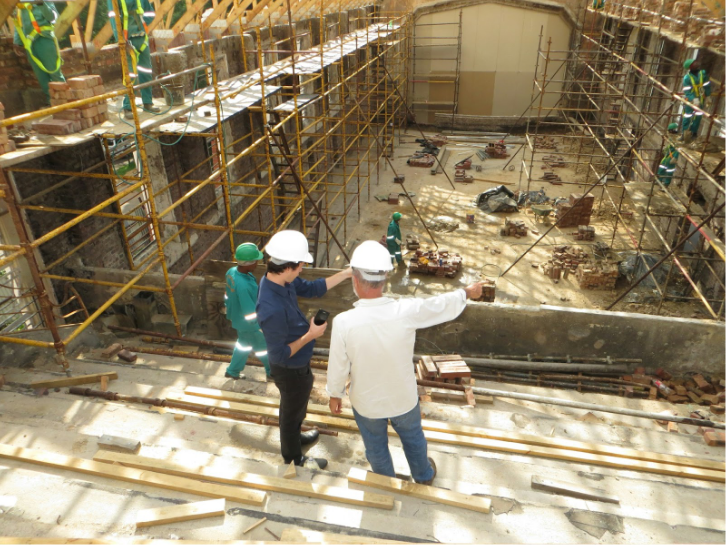With a better understanding and by effectively harnessing big data, we can transform how we approach project management efficiency, risk assessment, and decision-making.
And this could be precisely what you’re looking for when turning your construction business into a legacy that can stand the test of time.
What is big data in construction management?
“Big Data in Construction Management” refers to the collection, analysis, and utilization of vast amounts of data generated throughout the lifecycle of construction projects.
Increasingly over the last few years (with reports showing that big data had increased interest across the construction industry since 2016, while other forms of data, such as BIM (Building Information Modelling), were around as far back as 1975, big data has become an integral part of project planning, execution, and monitoring.
To make this simple, by leveraging advanced analytics tools and technologies, construction companies can gain valuable insights from the enormous volume of structured and unstructured data generated on job sites.
FMI reports that over 2.5 petabytes of data are generated every single day by construction companies, yet a staggering 95% of that data goes unused or underutilized, leading to a ton of wasted potential.
Anterra’s CPM platform is focused on refining, cleaning, and optimizing actionable data allowing leaders to use a data-driven approach to enable more informed decision-making, enhance project efficiency, improve risk management, and ultimately lead to better project outcomes.
Current statistics show that “full-scale digitalization of non-residential construction is estimated to lead to an annual global cost saving of over $1.2 trillion (21%) within the next ten years.”
Even government projects are expected to achieve a 15%-25% decrease in construction and engineering expenses across transportation and power plant projects through the use of data and digitalization.
All leading to more revenue, protected margins, increased safety, better client experiences, and wins for everyone from project managers and site superintendents to your financial team.
What’s more, modern data technology allows big data in construction to benefit from:
- Monitoring of project progress and margin erosion
- Resource utilization and costly overtime due to timeline slippage
- Automatic company-wide, division, and project-level cash flow forecasting based on projected billings and costs
- Equipment performance
- The ability to identify potential issues before they escalate
- Giving shareholders concise reporting including balance sheets and income statements
How does construction management collect big data?
Data collection starts with what you’re already tracking in your enterprise resource planning (ERP) tool – whether it be Sage 300 CRE, Acumatica, or Viewpoint – this is really the foundation for any construction company. However, data collection can be fairly diverse in construction from mobile location-aware time-clock applications to drones and cameras and even internet-connected devices and sensors (IoT) technology on equipment or at site locations.
And you can get incredibly detailed with this.
For example, equipment and machinery can be monitored, as can workers and environments. Sensors may monitor factors like temperature, humidity, vibration, and structural integrity.
Wearable technology worn by workers can provide data on their location, health, and safety conditions.
When data is collected in this way daily, throughout the entire working day, and across all the projects you undertake over the years, the data you have becomes, well, big.
All the schedules, resource allocations, budgets, BIM and custom ad-hoc reports, and more.
It’s a big collection of data. Big data.
You may even include other data sources, from third party joint venture partners, human resource records, inspection results, weather reports, and even 3D photogrammetry site surveys.
The integration of these diverse data sources creates a comprehensive picture of the construction project, enabling more effective management and decision-making.
What’s the role of big data in the construction industry?
There are a few core reasons why big data plays such a transformative role in the construction industry, but at its core, it’s about understanding what’s going on at every level of your company and making insightful decisions based on facts.
For most managers, this will include:
- Improving efficiency (AI and machine learning in construction can help find by up to 50%)
- Reducing costs, with 33% of construction companies identifying cost reduction as the #1 benefit
- Enhancing decision-making, with 70% of contractors believing that usage of advanced analytics improves productivity
As you can imagine, this role spans every construction phase, from planning to execution and maintenance.
And when I say based on facts, I mean using complex data of real-time and long-term situations to forecast and minimize risks, optimize resource allocation, and streamline all workflows.
Consider a mid-sized construction company spending $500,000 annually on logistics and material transport between their project sites.
Without data analytics, project managers often overorder “just to be safe” or rush-deliver materials at premium prices when they run short.
By implementing equipment and material tracking in your company’s ERP and leveraging a system like the Anterra CPM Platform, managers can analyze patterns in material usage, delivery times, and storage costs. The data might reveal that Site A consistently orders 20% more concrete than needed, while Site B frequently pays rush delivery fees for steel beams.
Using this information, your team can optimize delivery schedules, consolidate orders, and maintain ideal inventory levels at each location.
In this way, big data empowers the construction industry to address challenges such as cost overruns, inefficiencies, and safety risks while promoting smarter and more sustainable practices.
Traditional methods vs. data-driven approaches
| Aspect | Traditional Methods | Data-Driven Approaches |
| Decision-Making | Relies on intuition and experience; prone to human error | Based on empirical data and advanced analytics for informed decisions |
| Planning & Estimation | Manual calculations with limited accuracy | Uses historical data for precise cost estimates, risk identification, and increased overall job forecasting accuracy |
| Collaboration | Fragmented communication using paper-based or siloed tools | Centralized platforms enable real-time collaboration and seamless data sharing |
| Efficiency | Time-intensive processes with higher chances of delays | Streamlined workflows through automation and predictive analytics |
| Safety | Reactive measures based on past incidents | Predictive analytics identify risks in advance, improving worker safety |
| Resource Utilization | Limited tracking of materials and equipment | Optimized resource allocation using crew monitoring with simple mobile applications integrated to your bigger picture |
What are the practical applications of big data in construction?
So, while in theory, big data can offer a wealth of benefits to construction managers, what does this actually look like in the real world? Well, let’s take a look.
Project planning and estimation
Use big data to overhaul and refine how you plan and estimate your construction projects.
By leveraging historical data and real-time information construction companies can create more accurate cost estimates, optimize project schedules, and allocate resources effectively.
This data-driven approach helps to improve cash flow forecasting, mitigate risks, avoid cost overruns, and ensure projects stay on track and within budget.
Design and modeling
Integrating big data into BIM tools enhances the design and modeling process.
BIM systems can now incorporate real-time data from the construction site, such as weather conditions, material availability, and equipment performance.
This allows for dynamic design adjustments, improved collaboration among stakeholders, and better visualization of the project lifecycle.
Construction monitoring
Big data enables real-time monitoring of construction projects, providing valuable insights into progress, safety, and quality.
By utilizing IoT sensors, mobile devices, drones, and wearable technology, construction managers can track the location and performance of equipment, monitor the structural integrity of buildings, and ensure worker safety.
This real-time visibility helps to identify potential issues early on and facilitates proactive interventions to keep projects on schedule and within budget.
Supply chain management
You can use analytics to optimize the construction supply chain by improving material procurement, inventory management, and logistics.
This is achieved by analyzing historical data, market trends, and supplier performance, enabling you to make informed decisions about sourcing materials, negotiating contracts, and managing inventory levels.
Overall, this helps to reduce costs (up to a staggering 47%), minimize waste, and ensure timely delivery of materials to the job site.
Predictive maintenance
A lot of construction companies fall into the habit of reactive maintenance. Basically, when things go wrong, then they get fixed, and workers spend a lot of time with their fingers crossed that the equipment is going to work.
Of course, this comes with a wealth of safety and technical risk.
And likewise, you don’t want to spend a ton of time on costly maintenance that keeps projects held back.
The middle ground is to use big data to instead implement “predictive maintenance”.
By analyzing data from sensors embedded in machinery, you can predict when equipment is likely to fail and schedule maintenance proactively. This helps to prevent costly downtime, extend the lifespan of equipment, and optimize maintenance schedules.
Risk management
Combining data from multiple sources allows you to seriously enhance risk management by identifying potential hazards and enabling proactive mitigation strategies. This applies to safety, weather, labor, and supply chain disruptions, all based on real-time data, historical data, and current market trends.
This allows for developing effective risk mitigation plans, reducing the likelihood of project delays, cost overruns, and safety incidents.
As technology continues to evolve, we can expect even more innovative applications of big data to emerge, further transforming how we design, build, and manage construction projects.
What are the challenges and solutions in implementing big data in construction management?
While big data offers numerous benefits to the construction industry, as with anything in life, there are some potential challenges that come with implementation. Understand these challenges, and you can mitigate the pitfalls that can cause more harm than good.
Challenges
- Lack of big data awareness: Many construction professionals and companies have a limited understanding of big data concepts, benefits, and applications specific to the construction industry. This results in falling behind and not being able to nurture the best results. Since you’ve made it this far, you’re already on the right path.
- High cost of investment: Implementing big data solutions on your own often requires significant upfront costs for infrastructure, software, and training. Partnering with a company focused not just on big data, but also with construction industry experience is key. Rolling a solution on your own could cost hundreds, of thousands, so implementing what you need is important.
- Resistance to change: The construction industry is known for its adherence to traditional practices, making adopting new technologies like big data difficult. This applies to managers, finance staff, project managers, site managers, and shareholders alike.
- Lack of technological expertise: There is a shortage of skilled professionals who can effectively implement and manage big data solutions in construction.
- Data quality and management issues: Construction projects generate vast amounts of unstructured data, making it challenging to ensure data quality, proper labeling, and efficient management.
- Security concerns: The sensitive nature of construction project data raises concerns about data privacy, security, and compliance. Anterra has focused on data security, integrity, and both data in-transit and data at-rest encryption.
- Integration with existing systems: Incorporating big data solutions with legacy systems and processes can be complex, time-consuming, and expensive.
Solutions
- Develop phased implementation strategy: Focus your implementation on a few specific goals (AR Collections, Job Forecasting, Cash Flow) then adoption within the department(s) all while benefiting from reporting rolled up at the corporate level.
- Promote a data-driven culture: Anterra has over a decade of experience, and we only focus on the important parts of big data picture, but we’re your partner throughout your entire journey.
- Invest in training and talent development: Develop in-house expertise by providing specialized training to existing staff. Leverage Anterra’s AdHoc add on tools to answer business-specific questions or integrate data from 3rd parties like SalesForce, human resources tools, bidding tools, or crew tracking.
- Implement robust data governance and security frameworks: Establish clear data management solutions and protocols, including data collection, storage, and quality control processes. anterraDataCenter is Anterra’s on-prem product which makes replicating data from the most used and one of the oldest ERPs in existence, Sage 300 CRE, a breeze.
- Adopt cloud-based solutions: Leverage cloud computing to reduce infrastructure costs and improve scalability. Anterra has built a turnkey standardized model for construction data analytics and tools from several of the industry’s most popular ERPs.
- Collaborate with technology partners: Partner with experienced technology providers and consultants who specialize in big data solutions for the construction industry. This can help overcome the lack of in-house expertise and accelerate implementation.
- Establish clear ROI metrics: Define and track key performance indicators (KPIs) that drive your business. Anterra’s CPM Platform comes out-of-the-box with widgets and customizable pivot grids that already track the industry’s best-practices metrics.
By addressing these challenges and implementing these solutions, construction companies can successfully leverage big data to improve project outcomes, enhance efficiency, and drive innovation in the industry.
Wrapping up
The construction industry is on the cusp of a digital revolution fueled by big data. By harnessing the power of data analytics, construction companies can enhance project planning, optimize resource allocation, improve safety measures, and drive sustainable practices.
While there are challenges to overcome in implementing big data solutions, the potential benefits are immense.
And then as we look to the future, the integration of AI, Machine Learning, and advanced BIM systems will further revolutionize the construction industry.
The truth is, by embracing a data-driven culture and staying ahead of emerging trends, you can position yourself for success in this exciting new digital construction era.
If you’re looking for more personalized guidance and support, or you want to get started with construction-ready data solutions, contact a rep here at Anterra – the modern big data construction specialist.
FAQs
What is big data in construction?
Big data in construction refers to the vast amount of information collected from various sources throughout the lifecycle of construction projects.
This includes data from equipment, employees, planning tools, Building Information Modeling (BIM), contracts, sensors, and more.
When analyzed properly, this data can provide valuable insights to improve decision-making, efficiency, and project outcomes.
What are the benefits of using big data in construction?
Some key benefits include:
- Reducing project costs and improving budget management.
- Enhancing project planning and resource allocation.
- Improving safety on construction sites.
- Optimizing equipment use and maintenance.
- Enabling more accurate bidding and estimations.
- Increasing overall productivity and efficiency.
How is big data transforming the construction industry?
Big data is revolutionizing construction by:
- Enabling data-driven decision-making.
- Improving risk analysis and management.
- Enhancing project planning and modeling through Building Information Modeling (BIM).
- Facilitating predictive maintenance of equipment.
- Optimizing resource utilization and reducing waste.
- Improving collaboration and communication among stakeholders.
What are some challenges in implementing big data in construction?
Common challenges include:
- Lack of awareness and understanding of big data concepts.
- High initial investment costs for infrastructure and training.
- Resistance to change in a traditionally conservative industry.
- Shortage of skilled professionals to implement and manage big data solutions.
- Data quality and management issues.
- Security and privacy concerns.
How can construction companies start leveraging big data?
To start using big data effectively, construction companies should:
- Invest in data infrastructure and talent.
- Foster a data-driven culture within the organization.
- Implement integrated data platforms.
- Focus on predictive analytics.
- Prioritize data security and privacy.
- Collaborate with technology partners specializing in construction analytics.
What is the future of big data in construction management?
The future of big data in construction is likely to include:
- Widespread adoption of AI and machine learning for advanced analytics.
- Integration of Internet of Things (IoT) devices for real-time data collection.
- Development of more sophisticated Building Information Modeling (BIM) systems.
- Increased use of autonomous construction equipment.
- Greater focus on sustainability-driven data analytics.
- Enhanced predictive capabilities for project outcomes and risk management.





